
The Eli Whitney Museum, in Hamden, Connecticut, is an experimental learning workshop for students, teachers, and families. The museum's main building is located on a portion of the Eli Whitney Gun Factory site, a gun factory erected by Eli Whitney in 1798. The museum focuses on teaching experiments that are the roots of design and invention, featuring hands-on building projects and exhibits on Whitney and A. C. Gilbert.

Whitneyville is a neighborhood in the southeastern portion of the town of Hamden, Connecticut. It started in the early nineteenth century as a factory town for workers in Eli Whitney's gun factory. Around the turn of the twentieth century, it evolved into a trolley suburb of New Haven. Today it is primarily residential, with a mixture of single-family homes and small apartment and condominium buildings. There is some commercial development centered around the intersection of Whitney and Putnam avenues.

The Smith–Harris House, listed on the National Register of Historic Places as the Thomas Avery House, is a 2+1⁄2-story clapboarded Greek Revival home on Society Road in East Lyme, Connecticut. It is believed that the farmhouse was built in 1845–1846 as a wedding gift for Thomas Avery and Elizabeth Griswold. It remained in the Avery family until 1877, when it was purchased by William H. Smith. By the 1890s, the farm was managed by Smith's younger brother, Herman W. Smith, and nephew, Frank A. Harris. In 1900, the two married Lula and Florence Munger, sisters, and both resided in the house. In 1955, the house was sold to the Town of East Lyme, and the sisters continued to live in the house until requiring a nursing home. The house was saved from demolition by citizens and restored. It opened on July 3, 1976, as a historic house museum, operated and maintained by the Smith–Harris House Commission and the Friends of Smith–Harris House. It is open from June through August and throughout the year by appointment. The Smith–Harris house was added to the National Historic Register of Places on August 22, 1979.
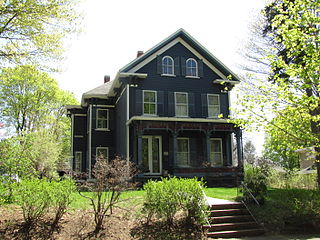
15 Wave Avenue is a well-preserved Italianate style house in Wakefield, Massachusetts. It was built between 1875 and 1883, and was listed on the National Register of Historic Places on July 6, 1989.

The Mount Carmel Congregational Church and Parish House is a historic church complex at 3280 and 3284 Whitney Avenue and 195 Sherman Avenue in Hamden, Connecticut. It consists of an 1840 Greek Revival church with a tetrastyle temple front portico, and a 1911 Colonial Revival parish house. A non-contributing 1925 sexton's house is also on the property. The church is considered to be Hamden's finest example of Greek Revival architecture, and the parish house one of its finest Colonial Revival houses. The property was listed on the National Register of Historic Places in 1991.

The Whitneyville Congregational Church, now the Whitneyville United Church of Christ, is a historic Congregational Church at 1247-1253 Whitney Avenue in the Whitneyville section of Hamden, Connecticut. The congregation is now affiliated with the United Church of Christ (UCC). The church building is a Greek Revival style built in 1834, with an interior altered in 1866 to designs by Rufus G. Russell. The church, along with its 1924 parish house, was added to the National Register of Historic Places in 1995 for its architecture.
Whitney Avenue is a principal arterial connecting Downtown New Haven with the town center of Hamden in the U.S. state of Connecticut. Most of the road within the city of New Haven is included in the Whitney Avenue Historic District, which is listed on the National Register of Historic Places. The designation begins at Grove Street in the northern part of Downtown New Haven and extends through the town of Hamden up to the Cheshire town line. North of Dixwell Avenue in Hamden Center, the road is a state highway and designated as part of Route 10. From the New Haven town line to Dixwell Avenue, the road is state-maintained with an unsigned designation of State Road 707. Within New Haven, Whitney Avenue is a town road. The J route of Connecticut Transit New Haven, which connects New Haven to Waterbury, runs along Whitney Avenue.

The William Pinto House, also known as William Pinto-Eli Whitney House, is a historic house at 275 Orange Street in New Haven, Connecticut. It is a Federal-style building of post-and-beam construction, and was built in 1810 for John Cook, a merchant. It is rare and unusual for its design, which places the gable end facing the street, rather than to the side as was more typical in the Federal period. It is historically notable for its second owner, William Pinto, a member of one of New Haven's leading Jewish families, and for its third occupant, Eli Whitney, who leased the house from Pinto in the later years of his life. The house was listed on the National Register of Historic Places in 1985. It now houses professional offices.
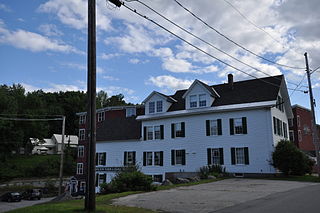
The Bass Boarding House is an historic house on Canal Street in Wilton, Maine, United States. It was built in 1860s, and adapted for use as worker housing for G.H. Bass & Co., whose former factory building stands next door. The building, one of a few that survive in Wilton that were adapted in this way, was added to the National Register of Historic Places in 1988. It now houses the Wilton Historical Society's Wilton Farm and Home Museum.

The Pratt House is a historic house museum at 19 West Avenue in Essex, Connecticut. With a construction history of one ell possibly dating to the mid-17th century, it is one of Connecticut's oldest surviving buildings, owned for 2+1⁄2 centuries by a single family. Now owned by the local historical society, its displays exhibit Pratt family and regional history. The building was listed on the National Register of Historic Places in 1985.

The John Waddey Carter House is a historic home located at Martinsville, Virginia. It was reportedly based on a design by architect George Franklin Barber and built in 1896. It is a two-story, irregularly massed, gray frame weatherboard sheathed Queen Anne style dwelling. It features a dominant two-story central gable, an asymmetrical one-story wrap-around porch, and a polygonal corner tower. It is topped by a standing-seam metal-clad hipped roof with steeply pitched lower cross gables. It also has a two-story bay window and service ell.
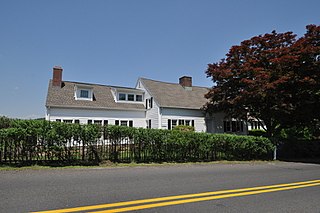
The Ebenezer Evans House is a historic house at 17 Long Bottom Road in Southington, Connecticut. Built about 1767, it is a well-preserved example of a Georgian Cape house. It was listed on the National Register of Historic Places in 1989.

140 and 144 Retreat Avenue is a historic conjoined pair of houses in Hartford, Connecticut. Built in 1844 and 1851, the two houses are the only surviving reminders of the street's 19th-century streetscape. They were listed on the National Register of Historic Places in 1982.

The Terry-Hayden House is a historic house on Middle Street in Bristol, Connecticut. Built in 1835 and enlarged in 1884, it is a well-preserved example of a Greek Revival house with a four-column temple portico. Now part of a professional office complex called Terry Commons, it was listed on the National Register of Historic Places in 1982.
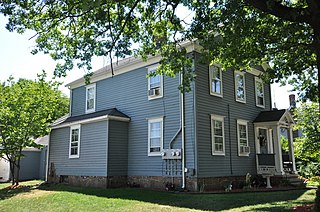
The George Atwater House is a historic house at 1845 State Street in Hamden, Connecticut. Built about 1820, it is a good local example of a vernacular Federal period farmhouse, with a well-preserved interior and unusual floorplan. It was listed on the National Register of Historic Places in 1992.

The Hamden Memorial Town Hall houses the municipal offices of the town of Hamden, Connecticut, and serves as a memorial to its military service people. Located at junction of Dixwell and Whitney Avenues and completed in 1924, it is a prominent local example of Colonial and Classical Revival architecture. It was listed on the National Register of Historic Places in 2001.
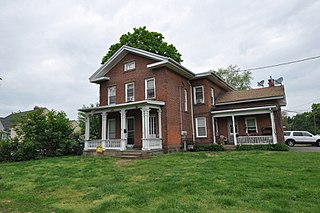
The Alphonso Johnson House is a historic house at 1 Gilbert Avenue in Hamden, Connecticut. Built in 1859, it is one of the town's few 19th-century brick houses, and a distinctive example of transitional Greek Revival-Italianate architecture. It was listed on the National Register of Historic Places in 1992.

The Michigan Avenue-Genesee Street Historic Residential District is a primarily residential historic district, located along Michigan Ave between Clinton Street and the railroad tracks, and along Genesee Street from Michigan Avenue to Shiawassee Street in Owosso, Michigan. It was listed on the National Register of Historic Places in 1980.

The Orrin Todd House is a historic house at 3369 Whitney Avenue in Hamden, Connecticut. Built about 1800, it is one of the best surviving examples of Federal period architecture in the town. It was listed on the National Register of Historic Places in 1991. It is presently owned by Quinnipiac University, and was rescued from demolition in 2017.

The David Perry House is a historic house at 531 Lafayette Street in Bridgeport, Connecticut. Built in 1826, it is the only known Federal period dwelling extant within the historic bounds of Bridgeport's original village center. It was listed on the National Register of Historic Places in 1984.




















